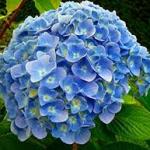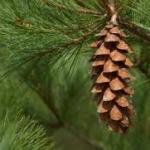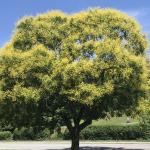A monthly e-newsletter from UMass Extension, published March to October, for home gardeners.
To read the articles in each section of the newsletter, click on the section headings below to expand the content:
Tips of the Month
July is the Month to.....
 Be prepared for gardening in the heat and humidity. Cool, loose-fitting clothing, a wide-brimmed hat, and sunblock are just as vital as rakes and hoes. Take rest and water breaks as often as needed and consider scheduling tasks that require exertion for early in the day. Educate yourself about the symptoms of heat-related conditions, such as heat exhaustion and heatstroke, and temper gardening enthusiasm with common sense!
Be prepared for gardening in the heat and humidity. Cool, loose-fitting clothing, a wide-brimmed hat, and sunblock are just as vital as rakes and hoes. Take rest and water breaks as often as needed and consider scheduling tasks that require exertion for early in the day. Educate yourself about the symptoms of heat-related conditions, such as heat exhaustion and heatstroke, and temper gardening enthusiasm with common sense!
Keep on weeding. Hot, sunny weather will cause pulled weeds to die quickly and any seeds unearthed during the weeding process will be less likely to germinate on the dry soil surface.
-
Freeze freshly picked strawberries, raspberries, and blueberries in a single layer on rimmed baking pans for several hours before transferring them to freezer bags for long-term storage. This two-step method makes it easier to scoop out exactly the amount you need from the freezer later, as berries are not frozen in a solid clump, but stay loose and separated.
-
Enjoy fresh herbs—mint leaves crushed in iced tea, basil shredded over salads and pasta, dill sprinkled over fish or in potato salad. A planter box or small kitchen garden close at hand will facilitate adding those last-minute garnishes. Keep plants that spread—mint and oregano, in particular—corralled in containers or be prepared to give them plenty of space away from better-behaved plants.
-
Cut and save herbs for winter use. Early- to mid-morning is an ideal time for cutting: after morning dew on plants has dried but before the heat of the day has caused their flavorful oils to dissipate. Preserve the flavor by freezing (mix chopped herbs into water in ice cube trays) or drying (hang stems upside down in a dry, dark, airy location until leaves are brittle).
-
Keep up with maintenance of annual containers. To keep plants lush and to promote continuous blooming, water plants and remove spent flowers regularly as well as fertilize weekly with a dilute water-soluble fertilizer. When watering, be sure to saturate the soil.
-
Dig up, divide, and replant perennials that bloomed early in the season. Cutting back stems by a third may make plants easier to transplant. It’s best to tackle this job on a cool, cloudy day when rain is imminent.
-
Harvest cucumbers and summer squash when they’re small, around 3 to 6 inches long. Frequent harvests will encourage additional fruit production. While you’re at it, dig up a few small new potatoes by using your hands to feel around for the thin-skinned tubers under the soil—no peeling needed, just wash and cook!
-
Monitor gardens for Japanese beetles. As a first line of defense, hold a jar of soapy water under the leaves of infested plants and shake beetles off into the jar.
-
Evaluate non-productive areas of the vegetable patch. Are there early season crops that have given up the ghost? Toss spent plants on the compost pile and plant summer cover crops, such as buckwheat or sudangrass.
-
Set up rain barrels underneath downspouts to capture rainwater for use on lawns and gardens. Make sure all barrel openings are screened to keep mosquitoes from using the water as a breeding site. The EPA offers an excellent web site on rain barrels, including information about the safety of using rain barrel water on vegetable gardens and links to state and regional resources: https://www.epa.gov/soakuptherain/soak-rain-rain-barrels
Jeninifer Kujawski, Horticulturist
Timely Topics
Maximizing Water Conservation in the Home Landscape
 In Massachusetts we get a fair amount of rain, on average about 45 inches annually. Unfortunately, the rain does not always fall according to when plants need it. Therefore, we often need to use supplemental watering to keep our lawns, flowers, or vegetables growing and healthy. This is especially true during the summer when water loss to the atmosphere is at its highest and rain events maybe few and far between. Both short term and long term drought conditions can stress our valuable water resources, whether public or private. This article will focus on some of the basic ways you can reduce your need for irrigation in the landscape as well as make the most of the water that is applied.
In Massachusetts we get a fair amount of rain, on average about 45 inches annually. Unfortunately, the rain does not always fall according to when plants need it. Therefore, we often need to use supplemental watering to keep our lawns, flowers, or vegetables growing and healthy. This is especially true during the summer when water loss to the atmosphere is at its highest and rain events maybe few and far between. Both short term and long term drought conditions can stress our valuable water resources, whether public or private. This article will focus on some of the basic ways you can reduce your need for irrigation in the landscape as well as make the most of the water that is applied.
As of July 3, 2019 there were no areas of the Northeast experiencing abnormally dry or drought conditions and most areas had more than normal precipitation amounts through much of the spring. However, during the summer months conditions can rapidly change and for many landscapes it only takes a week or two of no rain to stress plants and increase the need for supplemental irrigation. A rain gauge is an inexpensive tool that is priceless during the summer. Rain gauges provide precise information about precipitation in your landscape, which will help inform you irrigation practices. This is important in summer when rain events are more localized and precipitation amounts can vary drastically from one side of a town to another.
Turf
There are several ways to reduce the overall need for supplemental irrigation in lawns. One way is to use drought resistant turf grass species, such as tall or fine fescues. These grasses reduce the overall need for supplemental watering. Another option is to allow your lawn to go dormant. This is best suited for low maintenance lawns that receive little wear or traffic. Dormancy is a natural response many cool season grasses have to survive drought conditions. The lawn will turn straw colored but will remain alive. Lawns can go dormant for several weeks with little or no harm and will quickly bounce back to life and green up when favorable conditions return.
A straw colored lawn may not be acceptable to everyone, and some lawns should not be allowed to go dormant. Lawns that receive a lot of wear or traffic should not go dormant because it can significantly damage the grass. These lawns will need supplemental watering. The rule of thumb for proper watering is infrequently and deep. This will promote deep rooting and increase the lawn’s stress tolerance. To determine how often infrequent is, pay attention to the grass for clues. The clues signaling time to water include: a slight color change to bluish green, individual blades that roll or fold, or footprints in the grass do not rebound. These clues occur just prior to wilting, the best time to water a home lawn.
How long to water for is dependent on the type of equipment used and soil type. This will vary and therefore watering times vary. To determine how long you need to water, physically check to see how long it takes for water to penetrate to a depth of 5-6 inches. Avoid setting irrigation systems to turn on frequently and for short periods.
When seeding new lawns, use straw or mulch to reduce evaporation from the soil surface and reduce the frequency of watering needed.
Vegetable Gardens
In the vegetable garden, water can be conserved by adding organic matter on an annual basis. Organic matter improves the water retention properties of sandy soils and in clay soils allows better water penetration. The use of mulches like straw or plastic will also help by reducing water loss from evaporation.
When irrigating vegetables, it is preferable to use drip or soaker irrigation. This allows irrigation to be directed specifically to the crops you are growing, reducing the total amount of water needed. Another added benefit of drip /soaker irrigation is that it will not wet the foliage, which can reduce the potential for some foliar diseases. When overhead watering is necessary, try to water during the dew period (early morning) instead of in the evening or late morning. This will reduce the amount of time foliage is wet, again reducing the potential for foliar disease.
When watering vegetables, make sure the water penetrates the soil to a depth of 6-8 inches. Newly planted transplants and seeds will require frequent irrigation until the roots grow into the surrounding soil. Make sure adequate moisture is available when the edible portions of the plant are developing, as this is a critical stage to have sufficient soil moisture.
Ornamentals
Choosing the right plant for the right place is the first step to reduce your landscape watering needs. Choosing ornamental plants based on a site’s soil type and climatic conditions will minimize irrigation needs and likely increase the overall success of your plants. A good layer of mulch will also help reduce water loss from evaporation.
If supplemental watering is needed, it should be applied infrequently and deep. Make sure the irrigation wets at least the top 6 inches of soil. The use of drip or soaker hoses work well for gardens with flowers, shrubs, and trees by delivering water directly to the vicinity of the plant’s roots. If overhead irrigation is used, apply in early morning to reduce extending the time foliage may be wet.
Don’t forget newly installed plants require extra attention until the plants are established. The larger the transplant, the longer it takes for establishment. Small woody plants should receive supplemental irrigation at least through the first growing season, whereas larger transplanted trees may require supplemental irrigation for more than one season.
Other water conservation tips include the use of irrigation timers and rain sensors, which will keep you from excessively or needlessly watering. You may also consider collecting rainfall in a rain barrel for use later. These are just a few suggestions to help you conserve our valuable water resources.
Russ Norton, Agriculture & Horticulture Extension Educator, Cape Cod Cooperative Extension
News for Gardeners
Common Hydrangeas and Less Common Friends
 The blue flowers of bigleaf hydrangea (Hydrangea macrophylla) are the epitome of Cape Cod in the summer. Hydrangea species are some of the most popular landscape plants, which is evident by the number of new cultivars introduced every year. Hydrangea macrophylla is likely the best-known Hydrangea species worldwide. Hydrangea paniculata, or panicle hydrangea, has increasingly grown in popularity in American gardens due to better winter hardiness, greater adaptability, and better drought tolerance compared to other Hydrangea species. The number of distinct species of Hydrangea is debated by taxonomist and plantsmen, with sources ranging from 23 to 80 or more! The increasing number of hybrids and cultivars furthers the confusion, with hundreds of cultivars of Hydrangea macrophylla alone. There are six common species of hydrangea grown in American gardens:
The blue flowers of bigleaf hydrangea (Hydrangea macrophylla) are the epitome of Cape Cod in the summer. Hydrangea species are some of the most popular landscape plants, which is evident by the number of new cultivars introduced every year. Hydrangea macrophylla is likely the best-known Hydrangea species worldwide. Hydrangea paniculata, or panicle hydrangea, has increasingly grown in popularity in American gardens due to better winter hardiness, greater adaptability, and better drought tolerance compared to other Hydrangea species. The number of distinct species of Hydrangea is debated by taxonomist and plantsmen, with sources ranging from 23 to 80 or more! The increasing number of hybrids and cultivars furthers the confusion, with hundreds of cultivars of Hydrangea macrophylla alone. There are six common species of hydrangea grown in American gardens:
- Hydrangea macrophylla (bigleaf, French, or mophead hydrangea)
- Hydrangea paniculata (panicle hydrangea)
- Hydrangea arborescens (smooth hydrangea)
- Hydrangea quercifolia (oakleaf hydrangea)
- Hydrangea anomala ssp. petiolaris (climbing hydrangea)
- Hydrangea serrata (mountain hydrangea)
Of the common species, H. quercifolia and H. arborescens are native to Eastern North America. Less common hydrangea species that can sometimes be found in the trade include Hydrangea angustipetala, Hydrangea aspera, Hydrangea hetermalla (wooly hydrangea), and Hydrangea involucrata. Dr. Michael Dirr also mentions some additional species in his book Hydrangeas for American Gardens.
Hydrangea Culture
Soil. Hydrangeas need consistently moist, well-drained, soil rich in organic matter. Panicle hydrangeas are tolerant of a wider range of soil conditions as long as they are well-drained.
Light. Bigleaf, panicle, oakleaf, smooth and mountain hydrangea need full sun to part shade, but perform best when provided morning sun and afternoon shade or dappled light. It is important for moisture to be adequate when plants are sited in full sun. Panicle hydrangea is the most tolerant of full sun conditions. Climbing hydrangea can do well in full sun to shade.
Water. Adequate water is important for healthy hydrangeas. Bigleaf hydrangea in particular is very sensitive to drought-stress and may sometimes wilt even when water is adequate due to its high transpiration demand. In general, about 1” of water per week is needed. During especially hot, dry weather, additional water may be needed.
Fertilization. Hydrangea have moderate nutrient requirements. Slow-release fertilizers are great for providing nutrients slowly over time. Liquid fertilizer can provide more rapid greening. Keep in mind that there is such a thing as too much of a good thing; too much nitrogen can result in longer than normal stems with fewer flowers.
Flower Color. The flower color of bigleaf and mountain hydrangeas is the result of aluminum availability in the soil. Lower pH (or more acidic soils) have more available aluminum, which results in blue flowers. Higher pH results in lower aluminum availability and pink flowers. Soil pH of 5.5 or less results in blue flowers and above 6.5 leads to pink flowers. In between 5.5-6.5 are shades of purple. Aluminum sulfate can be added to the soil to make flowers bluer; apply according to package recommendations. The intensity of flower color is also cultivar dependent.
Pruning. Care should be taken when pruning hydrangeas since different species and cultivars of a species set buds at different times of the year. Bigleaf, oakleaf, and mountain hydrangea normally bloom on old wood and should be pruned after flowering. Newer cultivars of bigleaf and mountain hydrangea bloom on both new and old wood. It is best with these cultivars to plant them where they can grow to size without pruning (or be realistic that pruning will reduce the number of blooms). Panicle and smooth hydrangea bloom on new wood and should be pruned in late winter to early spring. Winter dieback can be common with bigleaf and smooth hydrangeas. Before pruning, it is best to wait until growth resumes in spring and then prune out any stems that do not have new growth.
Hydrangea Considerations
Winter hardiness of some hydrangea species can be problematic in Massachusetts. Panicle hydrangea and climbing hydrangea are the hardiest of the common species. Bigleaf and mountain hydrangea are hardy to zone 6(5) and are best sited in more protected areas in most areas of the state.
| Habit/Size | Flowers | Blooms on: | Fall Color | |
| Hydrangea anomala ssp. petiolaris | Vine: 30-40’ long | Lacecap; creamy white to greenish to yellow; fragrant | yellow | |
| Hydrangea arborescens | Shrub: 3-5’ x 3-5’ | Rounded, white | New | Pale yellow; not ornamental |
| Hydrangea macrophylla | Shrub: 3-6’ x 3-6’ | Rounded or lacecap; color can be pH dependent; pink, blue, purple, white, green | Old (some cultivars bloom on new and old) | Pale yellow; some cultivars can have good color |
| Hydrangea paniculata | Shrub: 8-15’ x 6-10’ | Panicle; white; flower can mature to lime, pink, or red | New | Not good |
| Hydrangea quercifolia | Shrub: 6-8’ x 6-8’ | Panicle; white; flower can mature to pink or red | Old | Red to red-purple |
| Hydrangea serrata | Shrub: 2-4’ x 2-4’ | Lacecap; color depends on soil pH, pink, blue, purple | Old (some cultivars bloom on new and old) | Leaves can develop red tints in summer that deepen in fall |
*Cultivar can alter size, flower color
Other Members of the Hydrangeaceae Family That Look Similar to Hydrangea Species
- Schizophrgma hydrangeoides (Japanese hydrangea vine) – similar in look to climbing hydrangea (hydrangeoides means “like the genus Hydrangea”).
- Deinanthe bifida (false hydrangea) – herbaceous perennial, leaves resemble those of hydrangea and flowers somewhat resemble hydrangea flowers.
- Platycrater arguta, cobweb flower – overall resembles mountain hydrangea but with narrower leaves. Zones 7-9.
Additional Information
Hydrangea macrophylla (bigleaf, French, or mophead hydrangea)
There are 100’s of cultivars, with new ones introduced every year! Cultivars can offer different flower attributes (lacecap vs. mophead, double flowers, larger flowers, longer flowering, repeat bloomer, etc.), dwarf sizes, mildew resistance, variations in foliage (dark green, red veins, fall color, variegated leaves).
Hydrangea paniculata (panicle hydrangea)
Dozens of cultivars and varieties are available. Newer cultivars offer smaller sizes (‘Little Lamb’, ‘Jane’ Little Lime™, ‘PIIHP-I’ Baby Lace™), variations in flower colors (lime-white, pink, white aging to pink), size of flowers, etc.
Hydrangea arborescens (smooth hydrangea)
The species is seldom planted as cultivars offer a better floral show. Cultivars include larger flowers, rounded flowers, pink flowers, double flowers, lacecap flowers, and stronger stems.
Hydrangea quercifolia (oakleaf hydrangea)
Not used as much as it could (or should) be. Offers multiple seasons of interest with interesting oak-shaped leaves, summer flowers, good fall color, and exfoliating bark. Cultivars offer larger flowers, flowers that age to variatons of pink and red, smaller size, and double flowers.
Hydrangea anomala ssp. petiolaris (climbing hydrangea)
True clinging vine, can also grow as a woody groundcover. Not many cultivars, but there are a couple that offer variegated leaves or multi-colored emerging leaves.
Hydrangea serrata (mountain hydrangea)
Similar features to bigleaf hydrangea, but smaller (although not always true of cultivars). Cultivars include lacecap and mophead flowers, double flowers, and improved cold hardiness.
Sources:
Dirr, M. 2004. Hydrangea for American Gardens. Timber Press.
Dirr, M. 2011. Dirr’s Encyclopedia of Trees and Shrubs. Timber Press.
Mandy Bayer, Extension Assistant Professor of Sustianable Landscape Horticultur
Trouble Maker of the Month
Dieback of Eastern White Pine: Pathogens, Pests and a Changing Climate
 Eastern white pine (Pinus strobus) is one of the most economically valuable and ecologically important forest trees in the northeast. It is also an abundant landscape tree with numerous cultivars available through the nursery trade. In recent years, white pines in the region have exhibited symptoms of decline, which include: yellowing/browning needles, premature needle shedding, thinning canopies, undersized shoots and needles, resinosis, branch dieback and death. Widespread health issues for white pine first developed in approximately 2009. In the ten years since these problems became apparent, a great deal has been learned and it’s now known that multiple fungal pathogens, an insect pest and a changing climate are responsible. First and most importantly, white pine needle disease (WPND) is primarily responsible for the symptoms that many trees exhibit and is caused by several fungal pathogens. Branch and trunk cankering, caused by Caliciopsis canker, is also as an important component of the decline complex although disease severity varies by region. Most recently, the eastern white pine bast scale has been identified as an important predisposing agent that helps facilitate Caliciopsis canker. What is particularly interesting about the pathogens and insect pest responsible for white pine decline is that each is known or believed to be native in eastern North America. The widespread distribution of symptomatic trees and lack of a non-native pathogen or insect lead researchers to investigate the role of environmental conditions, which have been altered by a changing climate. What they found was that an increase in temperature and precipitation from May through July has helped to fuel the WPND epidemic. It is believed that the issues facing eastern white pine will only continue but management options do exist to help improve the health and vigor of stressed white pines.
Eastern white pine (Pinus strobus) is one of the most economically valuable and ecologically important forest trees in the northeast. It is also an abundant landscape tree with numerous cultivars available through the nursery trade. In recent years, white pines in the region have exhibited symptoms of decline, which include: yellowing/browning needles, premature needle shedding, thinning canopies, undersized shoots and needles, resinosis, branch dieback and death. Widespread health issues for white pine first developed in approximately 2009. In the ten years since these problems became apparent, a great deal has been learned and it’s now known that multiple fungal pathogens, an insect pest and a changing climate are responsible. First and most importantly, white pine needle disease (WPND) is primarily responsible for the symptoms that many trees exhibit and is caused by several fungal pathogens. Branch and trunk cankering, caused by Caliciopsis canker, is also as an important component of the decline complex although disease severity varies by region. Most recently, the eastern white pine bast scale has been identified as an important predisposing agent that helps facilitate Caliciopsis canker. What is particularly interesting about the pathogens and insect pest responsible for white pine decline is that each is known or believed to be native in eastern North America. The widespread distribution of symptomatic trees and lack of a non-native pathogen or insect lead researchers to investigate the role of environmental conditions, which have been altered by a changing climate. What they found was that an increase in temperature and precipitation from May through July has helped to fuel the WPND epidemic. It is believed that the issues facing eastern white pine will only continue but management options do exist to help improve the health and vigor of stressed white pines.
Read more about eastern white pine health issues at https://ag.umass.edu/landscape/fact-sheets/dieback-of-eastern-white-pine
Nick Brazee, UMass Extension Plant Pathologist
Plant of the Month
Koelreuteria paniculata, Golden rain tree
Golden rain tree is a deciduous tree with an open-branching, irregularly-shaped habit when young, then maturing to a more uniform rounded crown. It is a medium sized tree, growing 30-40' high and wide. Native to Northern China, Korea and Japan, it is hardy in zones 5 – 8. Plants are best grown in moist, well-drained soil in full sun, but are adaptable to dry soil, and they can tolerate drought, heat, high pH and acidic soils. Leaves are pinnately compound with 7-15 leaflets, growing up to 18” long! In the spring, leaves emerge with a pinkish-bronze to purplish cast and mature to bright or dark green in summer. The leaves may turn to golden yellow in fall, but most of the time the fall color is disappointing. Golden yellow flowers appear in late June or July. Individual flowers are small (about ½”) but occur in long, terminal, 12-15 inch airy panicles. The common name refers to the “golden rain” produced by the falling flowers; the fallen blossoms often form an attractive golden carpet under the tree. The fruits are papery, lantern-like 1½-2” long capsules that change from green to yellow to brown. The brown capsules typically persist on the tree for a long time.
Golden raintree can be used a small shade tree, a lawn specimen tree, street tree or in groupings. Golden rain tree has no serious insect or disease problem, but canker diseases and leaf spots are possible.
Cultivars include:
- 'September' – has a broad-rounded habit and produces masses of yellow flowers in August and September. It is slightly less cold tolerant than the species, and is hardy to zones 5/6 – 8. At zone 5, it may struggle with hard winter conditions.
- 'Fastigiata' – has a distinct columnar form and seldom flowers; is less hardy than the species.
Geoffrey Njue, UMass Extension Sustainable Landscapes Specialist
Additional Resources
Landscape Message - for detailed timely reports on growing conditions and pest activity
Home Lawn and Garden Resources
Find us on Facebook! www.facebook.com/UMassExtLandscape/
Follow us on Twitter for daily gardening tips and sunrise/sunset times. twitter.com/UMassGardenClip
Diagnostic Services
The UMass Extension Plant Diagnostic Lab provides, for a fee, woody plant and turf disease analysis, woody plant and turf insect identification, turfgrass identification, weed identification, and offers a report of pest management strategies that are research based, economically sound and environmentally appropriate for the situation. Accurate diagnosis for a turf or landscape problem can often eliminate or reduce the need for pesticide use. Sampling procedures, detailed submission instructions and a list of fees.
The UMass Soil and Plant Nutrient Testing Laboratory at the University of Massachusetts Amherst provides test results and recommendations that lead to the wise and economical use of soils and soil amendments. The Routine Soil Analysis fits the needs of most home gardeners. Sampling procedures plus the different tests offered and a list of fees.
Spread the Word!
Share this newsletter with a friend! New readers can subscribe to our Home Gardener E-Mail List.

